"Your haircut is gay" may sound like a childish insult, but it can hurt.
In British classrooms and playgrounds, young people are experiencing homophobic bullying - whether they are gay or not.
Abuse will make 52,000 out of the estimated 215,000 LGBT pupils miss school. Around 70,000 will see their classwork suffer and 37,000 will change their education plans, lobby group Stonewall says.
One in five will be physically attacked at school, and half are discriminated against or live in fear of discrimination, according to the 2014 Youth Chances survey.
These stark facts are what one hundred teachers in South Gloucestershire tried to change, when they went to work wearing t-shirts with the word 'gay' emblazoned on the front.
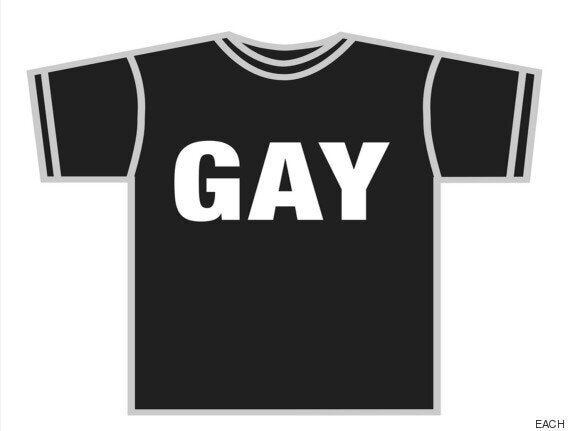
A mockup of the Bradley Stoke Community School t-shirts
Homophobic bullying wasn't actually a "noticeable problem" at Bradley Stoke Community School, a secondary academy on the outskirts of Bristol.
Susie Davis, the director of school support, says teaching staff wanted to try the T-shirt experiment to challenge "casual conversations about someone’s pencil case, trainers or choice of hairstyle being 'gay'".
But it wasn't until an anonymous student survey was carried out that they realised how strongly pupils felt about the problem. The results showed they saw the language as homophobic - and noticed that it was often directed towards students who weren’t openly gay, lesbian or bisexual. Respondents also called for harsh punishments for homophobic language and abuse, such as detentions, exclusions - and even the death penalty.
"It was clearly a very emotive topic," Davis says, and students were "very strongly telling us that they wanted us to take action".
So, the vast majority of Bradley Stoke's teachers - nearly 100 - spent a week wearing the 'gay' shirts to school, with some striking results.
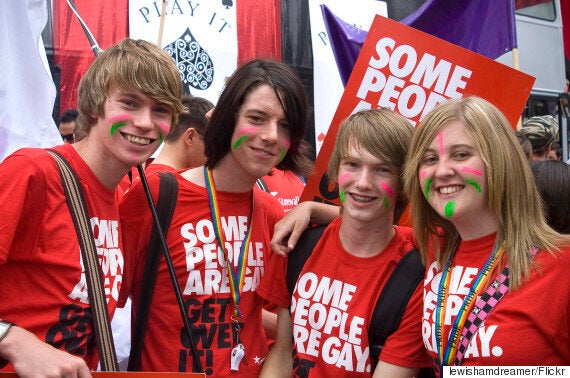
Stonewall has run a vocal campaign against homophobic bullying in schools
On the reverse side, the t-shirts spelled out the words ‘Good As You’, reflecting the fact that 'gay' is sometimes described as an acronym for Good As You.
There's no linguistic basis for this, but it captured the idea behind the t-shirts: if the school's teachers were happy to mark themselves with three letters that were generally used for taunts or jibes, perhaps it was ok to be gay.
The stunt's inspiration came from Jonathan Charlesworth, executive director of the charity Educational Action Challenging Homophobia (EACH). He works with hundreds of schools around the UK and devised Bradley Stoke's experiment.
The average British secondary school has around 1,200 students, and roughly 30 will grow up to identify as LGBT, Charlesworth told The Huffington Post UK.
Young people are immensely influenced by what teachers wear, he says: "Children take an enormous amount of awareness from what their teacher does, what they say, what they look like, and what they wear - much more than I think we realise they do."
Charlesworth, who is also an expert adviser to the National Crime Agency, explains that the simple t-shirts had a "seismic" effect "because they allowed the teacher to open up a dialogue with that young person and their friends."
"A teacher could be standing in a corridor and say: 'You know when you call homework 'gay'? If somebody hears that and they are gay, or they have gay family or friends, then they might be affronted by it.' And then the student goes 'oh' and wanders off down the corridor and has a think about that."
A t-shirt was an unavoidable way of getting attention, he says: "With lots of bodies moving around the school all day it’s a very easy and accessible way in which students can see a point and a message, and then ask their teachers about it. It has a great immediacy rather than a poster on a wall or something on a noticeboard.”
Teaching in the corridors - even about sexuality - is essential, he says. "It’s just a widening of any teachers’s pastoral responsibilities. You don’t have to be a PSHE [personal, social and health education] teacher to do it: it’s just part of one’s duty of care really."
And teachers are particularly crucial stopping homophobic bullying - as opposed to other kinds of bullying - because its victims are usually isolated, Charlesworth claims.
"There’s often a reluctance to come forward and report what’s happening because [young people] think they’re going to have to have a discussion about sexuality. Maybe they are not gay, or maybe they aren't sure if they are and they’re not necessarily ready to talk about it.
"If you are black or Asian or Jewish, you can go home and, in most circumstances, conversations by parents and siblings will be taking place in front of you, about issues and what’s happening on the news, and that can be a comfort and a support.
"But most gay young people don’t to home to gay parents, or they might be a heterosexual person who does go home to gay parents and doesn't necessarily want to have that conversation with their ‘mums’ for any number of reasons. Different forms of bullying can often look the same symptomatically, but they come from different places."
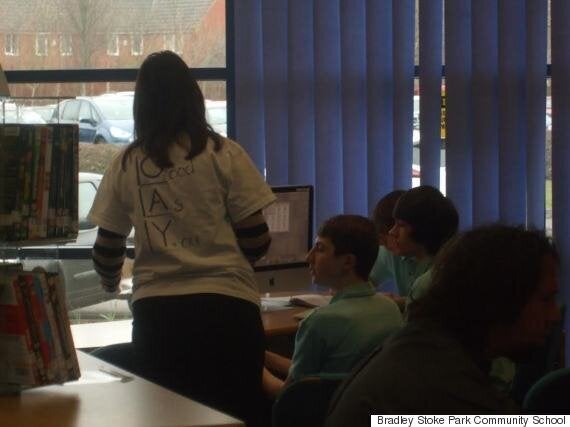
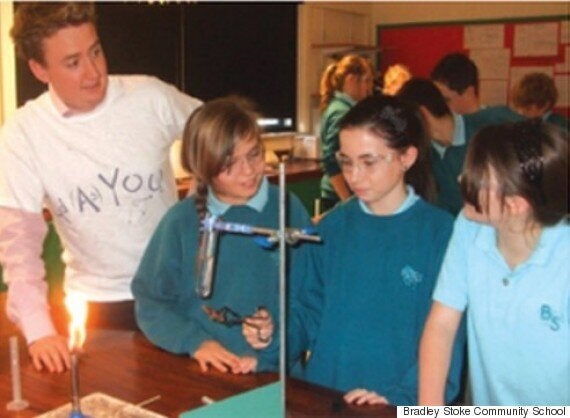
One of the hurdles to reaching young people is the fact that few gay teachers are "out" to their pupils - something Charlesworth often discusses with teaching unions. If all of a young person's school role models are apparently straight, he argues, it restricts the knowledge available to them.
"It's 2015 and we have thousands of secondary schools, but vast proportions of those staff rooms have gay and lesbian teachers in them who aren't out,” he explains.
“I’m not an advocate of all teachers rushing to come out to pupils, because people’s private lives are their own prerogative, I absolutely respect that. But it is an interesting illustration of society that if you worked in a lot of fields other than teaching, you'd be able to say to a colleague that you are gay."
"There aren't many figures available on the number of LGBT teachers, but we know anecdotally that there is still a reluctance among teaching staff to be out."
The groundbreaking experiment - back in February 2013 - was a hit. As the teachers strolled the halls dressed in identikit 'gay' tops, students asked them what on earth was going on.
"We didn't give students any warning," David says. "This focus caused quite a stir and certainly had an impact.
“They were just really interested, and there were many many, conversations. A student would ask: 'Well, why are you all wearing that Miss?' and I’d say "Well this about us all thinking together about how we use language, and how it’s derogatory and unpleasant for some people. That’s exactly what we wanted to do - it was a high impact strategy.”
As well as language, teachers revealed in a post-event report that the t-shirts prompted discussion about the civil rights movement and the struggle for gay and transgender equality.
And they "absolutely, definitely" caused students to reduce their use of the word 'gay' in a negative way, says Davis.
In an Ofsted report two months later, inspectors rated the behaviour and safety of pupils at Bradley Stoke as "outstanding" and specifically named the T-shirt experiment.
"The school's openness and the strategies used to tackle harassment and educating students in the different forms of bullying are outstanding," it noted, saying that the 'gay' t-shirts were "highly effective" in raising awareness about homophobic bullying.

Bradley Stoke's Ofsted report highlighted the t-shirts
It added that it saw "very little bullying" at the school and "any bullying that is reported is dealt with quickly"
Another glowing comment observed the students were developing morally, spiritually and culturally, into "highly informed and reflective young people."
Charlesworth and Davis are calling for the t-shirt tactic to be adopted in other schools. In fact, Bradley Stoke has revisited the approach for a week looking at sexism and "banterous" behaviours which could lead to bullying.
Whatever the reason, most schools aren't doing enough: 65% of gay or transgender pupils said their school "supports its pupils badly" when it comes to anti-gay bullying, the 2014 Youth Chances survey found.
The Bradley Stoke approach - and other direct, practical actions like it, could soon be copied across the UK and have already been used in some schools.
Vic Goddard, the principal of Passmores Academy and star of TV show Educating Essex, calls Charlesworth's book, 'That's So Gay!' an "agent for change in my school.”
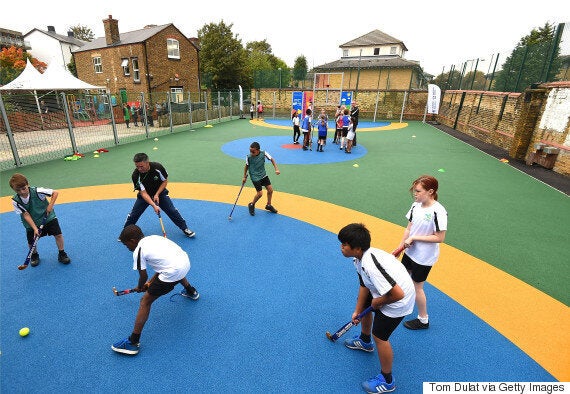
Schools are not helping LGBT children enough, the Youth Chances survey found
Labour this month proposed plans to "eradicate" homophobic bullying by training all teachers in dealing with it, and making sex education compulsory in primary schools. Shadow education secretary Tristram Hunt said "there is no place for it in our society - and never should it be ignored in our schools.”
But teaching about sexuality younger - which campaigners would argue is key to stopping abuse - is something the right wing press is fervently opposed to.
Even before training is compulsory - the inspiration and the tools are easy to work into regular teaching. Charlesworth suggests other tactics such as conducting an 'attitudes survey' of the school, encouraging students to note down all homophobic name-calling they hear, or how often they see heterosexual couple in the media and advertising, and voting for a gay role model.
Children could also learn about Alan Turing, the WWII codebreaker who was convicted because of his sexuality and whose story has resurfaced with the film The Imitation Game.
Although the benefits of these tactics haven't been rigorously measure, Davis points out that the T-shirt week had a far wider goal than teaching kids about sexuality and getting them to stop saying "gay".
"This wasn’t just about having a focus week, it was about starting to build the foundations where young people feel safe and secure to simply be themselves."
